Starte rUnit My name's Gina. Section A 1a-2e课件(共35张PPT内嵌音频)2023-2024学年人教版七年级英语上册
文档属性
| 名称 | Starte rUnit My name's Gina. Section A 1a-2e课件(共35张PPT内嵌音频)2023-2024学年人教版七年级英语上册 | 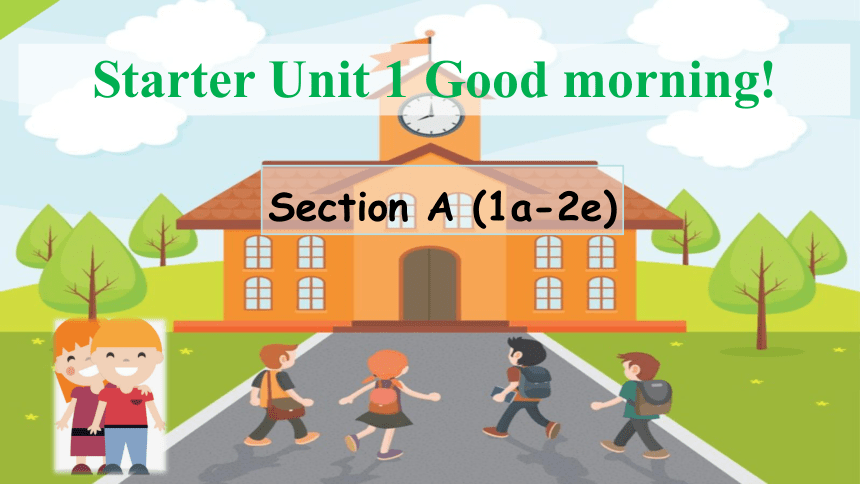 | |
| 格式 | pptx | ||
| 文件大小 | 24.9MB | ||
| 资源类型 | 教案 | ||
| 版本资源 | 人教新目标(Go for it)版 | ||
| 科目 | 英语 | ||
| 更新时间 | 2023-07-05 07:06:42 | ||
图片预览

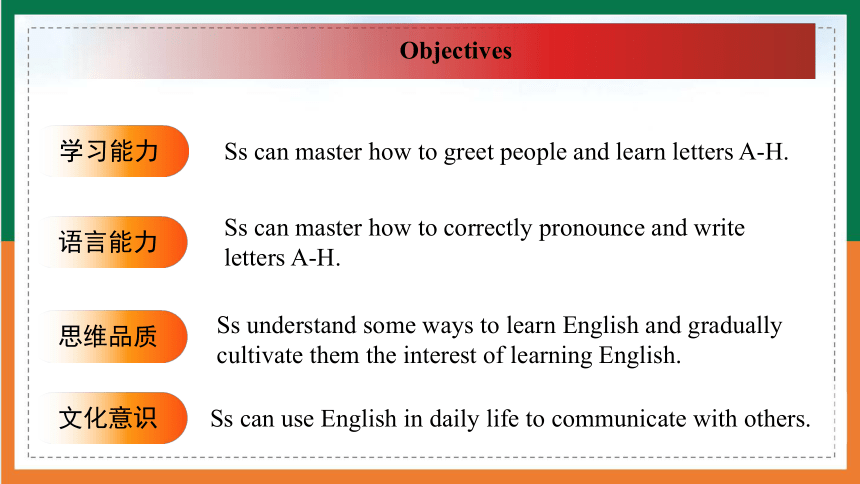
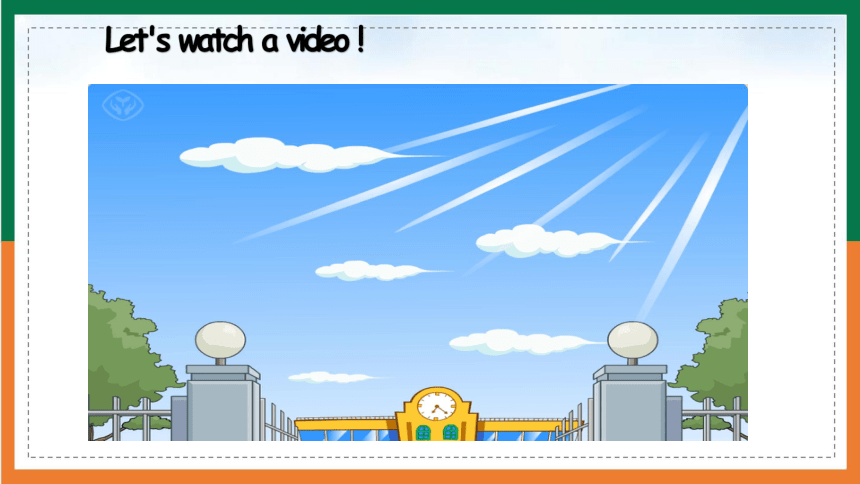
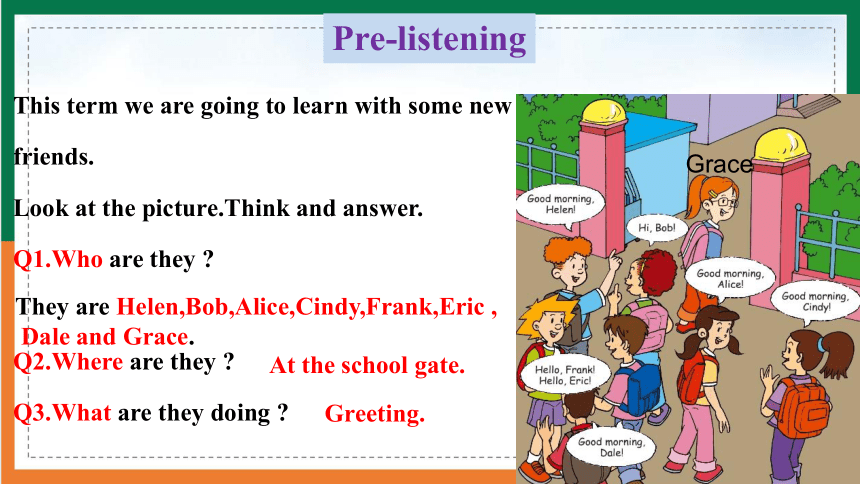
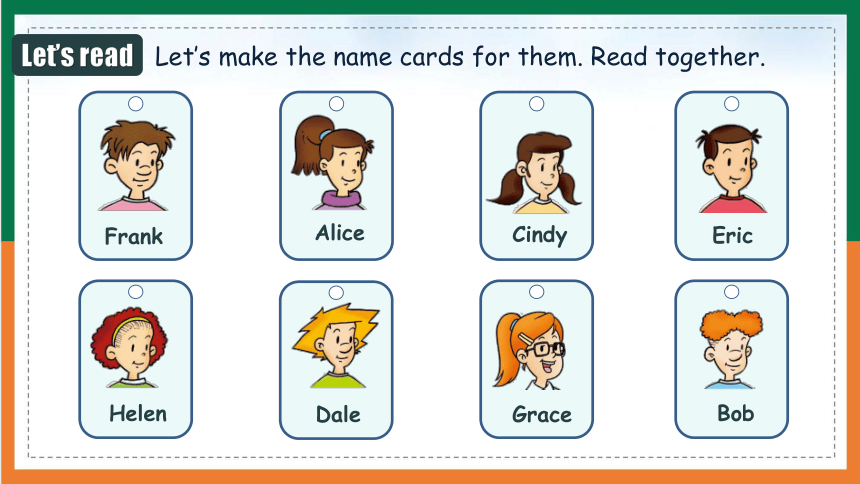
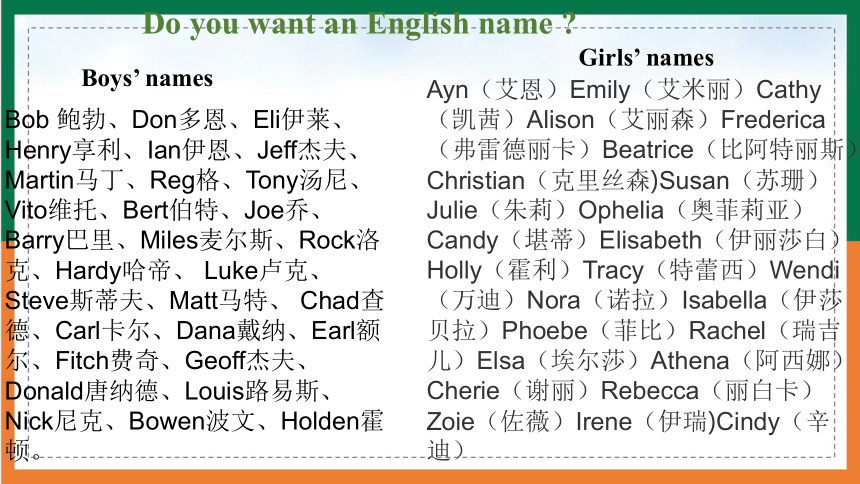
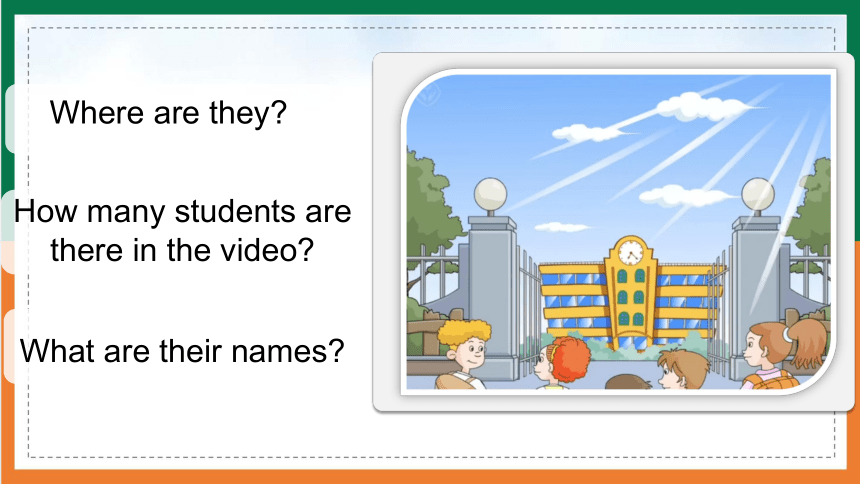
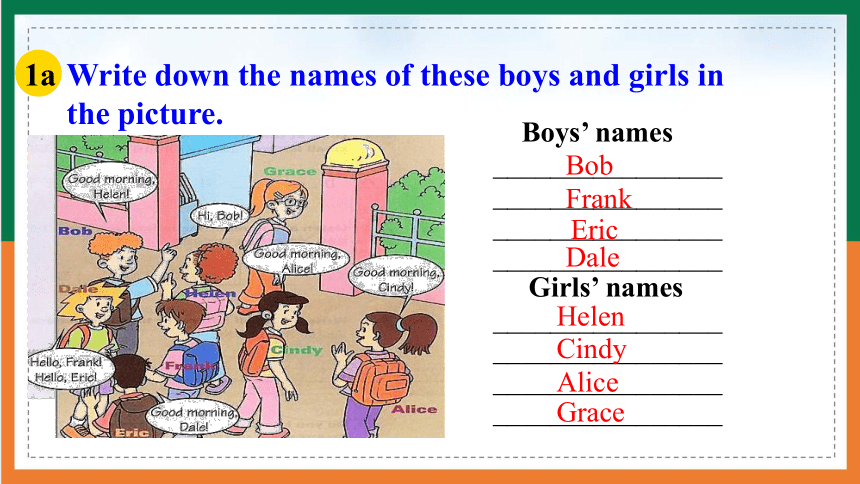
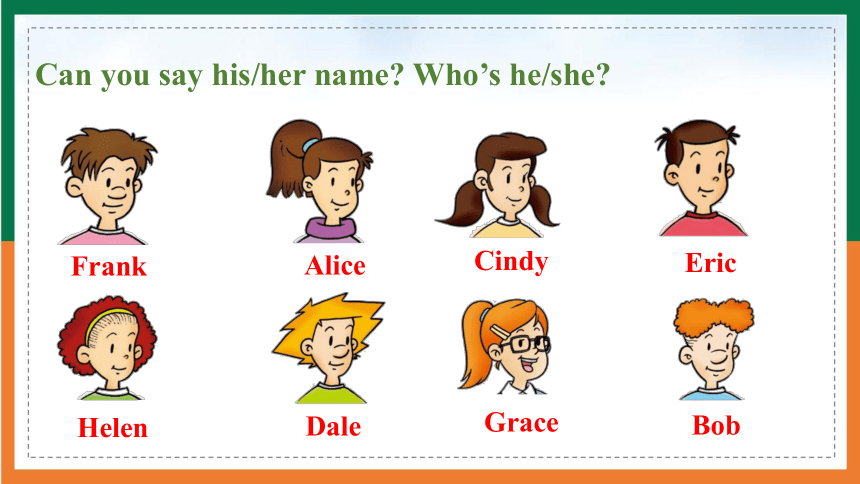
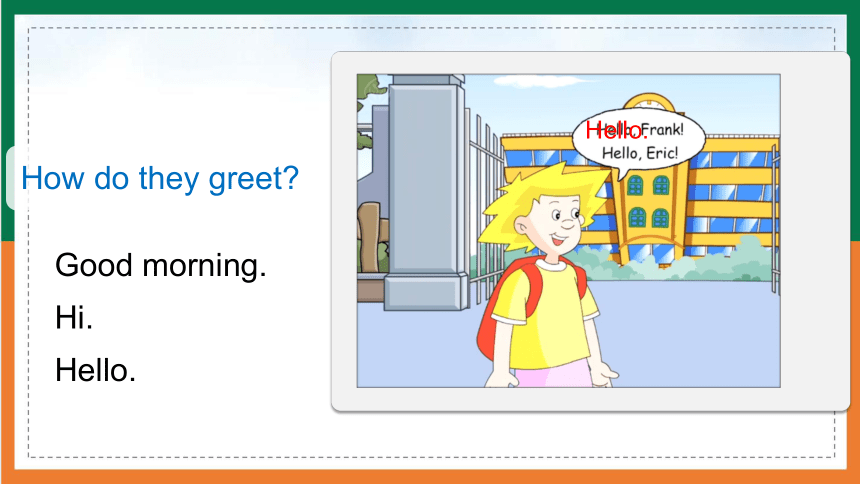
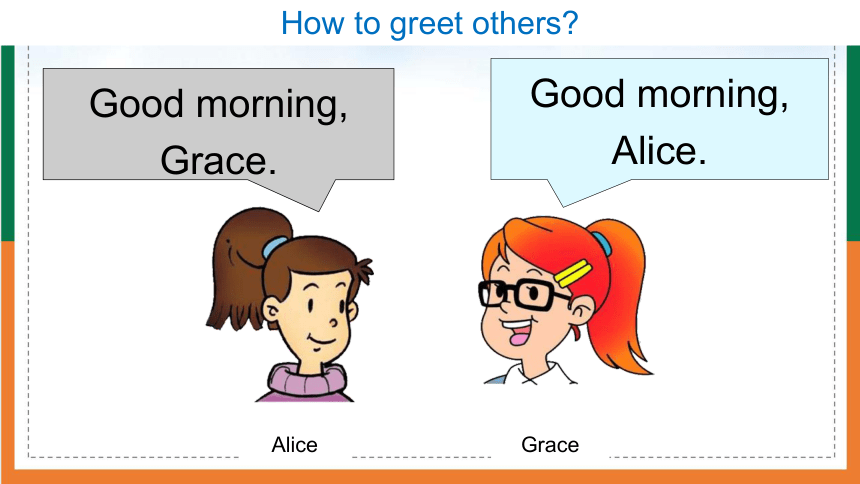
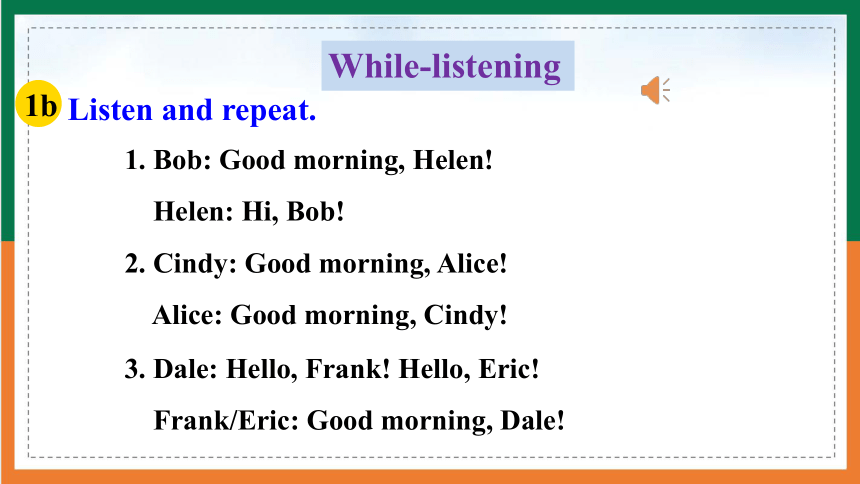
文档简介
(共35张PPT)
Section A (1a-2e)
Starter Unit 1 Good morning!
Objectives
Ss can master how to greet people and learn letters A-H.
Ss can master how to correctly pronounce and write letters A-H.
Ss understand some ways to learn English and gradually cultivate them the interest of learning English.
Ss can use English in daily life to communicate with others.
文化意识
语言能力
思维品质
学习能力
Let's watch a video !
Pre-listening
This term we are going to learn with some new friends.
Look at the picture.Think and answer.
Q1.Who are they
Q2.Where are they
Q3.What are they doing
Grace
Greeting.
At the school gate.
They are Helen,Bob,Alice,Cindy,Frank,Eric ,
Dale and Grace.
Let’s read
Let’s make the name cards for them. Read together.
Bob
Cindy
Grace
Frank
Dale
Alice
Eric
Helen
Do you want an English name
Bob 鲍勃、Don多恩、Eli伊莱、Henry享利、Ian伊恩、Jeff杰夫、Martin马丁、Reg格、Tony汤尼、Vito维托、Bert伯特、Joe乔、Barry巴里、Miles麦尔斯、Rock洛克、Hardy哈帝、 Luke卢克、Steve斯蒂夫、Matt马特、 Chad查德、Carl卡尔、Dana戴纳、Earl额尔、Fitch费奇、Geoff杰夫、Donald唐纳德、Louis路易斯、Nick尼克、Bowen波文、Holden霍顿。
Boys’ names
Girls’ names
Ayn(艾恩)Emily(艾米丽)Cathy(凯茜)Alison(艾丽森)Frederica(弗雷德丽卡)Beatrice(比阿特丽斯)Christian(克里丝森)Susan(苏珊)Julie(朱莉)Ophelia(奥菲莉亚)Candy(堪蒂)Elisabeth(伊丽莎白)Holly(霍利)Tracy(特蕾西)Wendi(万迪)Nora(诺拉)Isabella(伊莎贝拉)Phoebe(菲比)Rachel(瑞吉儿)Elsa(埃尔莎)Athena(阿西娜)Cherie(谢丽)Rebecca(丽白卡)Zoie(佐薇)Irene(伊瑞)Cindy(辛迪)
Where are they
How many students are there in the video
What are their names
1a
Write down the names of these boys and girls in the picture.
Boys’ names ________________________________________________________________
Girls’ names
________________________________________________
________________
Bob
Cindy
Grace
Frank
Dale
Alice
Eric
Helen
Can you say his/her name Who’s he/she
Bob
Cindy
Grace
Frank
Dale
Alice
Eric
Helen
Hi.
Hello.
Good morning.
Hello.
How do they greet
Good morning, Grace.
Good morning, Alice.
How to greet others
Alice
Grace
While-listening
1b
1. Bob: Good morning, Helen!
Helen: Hi, Bob!
Listen and repeat.
2. Cindy: Good morning, Alice!
Alice: Good morning, Cindy!
3. Dale: Hello, Frank! Hello, Eric!
Frank/Eric: Good morning, Dale!
Greet your partner.
Pair work
1c
Good morning,…!
Hi, …!
第一次见面
Nice to meet you!很高兴认识你
Nice to meet you too!我也是!
How do you do 你好吗?
How do you do!你好!
Good afternoon/ Good evening !
Post-listening
1c
Practice the conversations in the picture. Then greet your partner.
Good morning, Helen!
Hi, Bob!
Good morning, Alice!
Good morning, Cindy!
Hello, Frank!
Hello, Eric!
Good morning, Dale!
Game Time: Hello chain!
Try to use different greetings and gestures!
All Ss stand up. S1 turns to S2, and greets S2 using one of the greetings and S2’s real name. When S2 responds, S1 sits down. Then the chain continues. The team with all Ss seated first is the winner!
When we meet out friends in the morning,we say “Hi./Hello./Good morning”. When we meet them in the afternoon or in the evening, what can we say
Good morning!
1e
Role-play conversations using the information in 1c and 1d.
A: I don’t have a partner to practice English with.
B: Maybe you should join an English club.
Q: I can’t get the pronunciation right.
Why don’t you listen to the words on the radio and repeat them every day
Q: I can’t understand when people talk to me in English.
Maybe you should join an English corner to practice speaking English.
Let’s listen
Listen and repeat.
2a
英语中有26个英文字母,其包括元音字母和辅音字母
元音字母有5个:a、e、i、o、u
在A-H中,有两个元音字母,分别为a、e
/e / /bi:/ /si:/ /di:/
/i:/ /ef/ /d i:/ /e t /
Let’s listen
Listen and number the letters you hear [1-8].
h
a
e
g
d
b
c
f
1
2
3
4
5
6
7
8
2b
Let’s write
Look and copy.
2c
Let’s learn
1.字母在四线格中不在双斜线/ /中,而有双斜线/ /是音标。
2.大写字母一律占上两格,小写字母占一格,两格或者三格。
3. 小写字母a、c、e占中间一格,b、d、h占上两格,g占下两格,f占三格。
4.字母分元音字母:Aa, Ee 辅音字母:Bb, Cc, Dd, Ff, Gg, Hh
5.书写时字母用书写体,而音标用印刷体,即照着印出来的写,不变。
1. Good morning!
Good morning!是人们早晨或上午见面时的问候语,其答语通常还是Good morning! 也可用Hi!/Hello!。问候他人时,称呼语通常放在问候语后,而且用逗号隔开。
—Good morning, Ben! 早上好,本!
—Good morning, Jack! 早上好,杰克!
Good morning! 早上好!
Language points
2. Hi!/Hello!
Hi!/Hello!用于熟人之间非正式场合下的问候,可单独使用,也可加称呼使用。hi和hello可互换,但hi比hello更随意、亲切一些。
—Hi/Hello, Cindy! 嗨, 辛迪!
—Hi/Hello, Kate! 你好,凯特!
Hi! 嗨; 喂! Hello! 你好; 喂!
Language points
A: Hi, …! How are you
B: I’m fine, thanks.
How are you /And you
A: I’m OK.
Practice: greet your classmate.
3. Good afternoon!
Good afternoon!是人们下午见面时的问候语,其答语通常还是Good afternoon! 也可用Hi!/Hello!问候他人时,称呼语通常放在问候语后,而且用逗号隔开。
—Good afternoon, Ben! 下午好,本!
—Good afternoon, Jack! 下午好,杰克!
Good afternoon! 下午好!
Language points
4. Good evening!
Good evening!是人们晚上见面时的问候语,其答语通常还是Good evening! 也可用Hi!/Hello!问候他人时,称呼语通常放在问候语后,而且用逗号隔开。
—Good evening, Alice! 晚上好,艾丽斯!
—Good evening, Bob! 晚上好,鲍勃!
Good evening! 晚上好!
Good night!并不是问候语,而是晚上分别时或就寝前的道别用语,含义是“晚安!”“再见!”
Language points
Hi, Alice!
How are you
I’m fine, thanks.
Eric
Grace
How are you
I’m OK.
How to greet friends
5. How are you
how意为“怎样”,you意为“你;你们”。How are you 是熟人间见面时常用的问候语,用来询问对方身体状况。答语有“I’m fine, thanks./I’m OK, thank you.” 等。还可以反问对方“How are you ”或“And you ”。
—How are you 你好吗?
—I’m OK, thank you. And you 我很好,谢谢。你呢?
How are you 你好吗?
Language points
4. I’m fine./I’m OK.
I’m是I am的缩写形式,fine作形容词,在此意为“健康的”,也可表示“美好的”。I’m fine.常用来对“How are you ”做出应答。
I’m fine. 我很好。
I’m OK.也常用来对“How are you ”做出应答。OK两个字母要大写,也可写作okay,在此处指身体状况好,相当于fine。
I’m OK. 我很好。
Language points
Language points
Point
字母Aa-Hh (教材PS2 2a)
字母Aa-Hh
1) 大写字母均占上两格。
2) 小写字母a, c, e占中格;b, d, h占上两格;g占下两格;f占三格。
3) 大写字母一笔写完的有C, G;两笔写完的有B, D;三笔写完的有A, E, F, H。
4) 小写字母一笔写完的有a, b, c, e, g, h;两笔写完的有d, f。
5) 在8个字母中,Aa和Ee是元音字母,其余是辅音字母。
thanks意为“谢谢”,相当于“thank you”,用来对他人的关心、帮助、夸奖、赞美、祝福和问候表示感谢。
—Your sweater is nice. 你的毛衣很漂亮。
—Thanks. 谢谢。
Thanks. 谢谢。
A
E
单个元音字母后面加单个辅音字母(r除外),再加一个不发音的字母e构成的音节。
开音节
绝对开音节
相对开音节
以一个发音的元音字母结尾的音节。
闭音节:以一个元音字母加一个或几个辅
音字母(r除外)结尾的音节,称为闭音节。
一、写出下列字母的大写和小写。
________________________________________________________
________________________________________________________
________________________________________________________
________________________________________________________
A a
D d
E e
H h
Exercise
1. 右边图片的应答语是:_________
A. Thank you! B. I’m OK. C. Good morning!
2. —Hello, Helen!
—__________
A. How are you B. I’m fine, thank you. C. Hello, Linda!
二、单项选择。
C
C
Thank you!
Section A (1a-2e)
Starter Unit 1 Good morning!
Objectives
Ss can master how to greet people and learn letters A-H.
Ss can master how to correctly pronounce and write letters A-H.
Ss understand some ways to learn English and gradually cultivate them the interest of learning English.
Ss can use English in daily life to communicate with others.
文化意识
语言能力
思维品质
学习能力
Let's watch a video !
Pre-listening
This term we are going to learn with some new friends.
Look at the picture.Think and answer.
Q1.Who are they
Q2.Where are they
Q3.What are they doing
Grace
Greeting.
At the school gate.
They are Helen,Bob,Alice,Cindy,Frank,Eric ,
Dale and Grace.
Let’s read
Let’s make the name cards for them. Read together.
Bob
Cindy
Grace
Frank
Dale
Alice
Eric
Helen
Do you want an English name
Bob 鲍勃、Don多恩、Eli伊莱、Henry享利、Ian伊恩、Jeff杰夫、Martin马丁、Reg格、Tony汤尼、Vito维托、Bert伯特、Joe乔、Barry巴里、Miles麦尔斯、Rock洛克、Hardy哈帝、 Luke卢克、Steve斯蒂夫、Matt马特、 Chad查德、Carl卡尔、Dana戴纳、Earl额尔、Fitch费奇、Geoff杰夫、Donald唐纳德、Louis路易斯、Nick尼克、Bowen波文、Holden霍顿。
Boys’ names
Girls’ names
Ayn(艾恩)Emily(艾米丽)Cathy(凯茜)Alison(艾丽森)Frederica(弗雷德丽卡)Beatrice(比阿特丽斯)Christian(克里丝森)Susan(苏珊)Julie(朱莉)Ophelia(奥菲莉亚)Candy(堪蒂)Elisabeth(伊丽莎白)Holly(霍利)Tracy(特蕾西)Wendi(万迪)Nora(诺拉)Isabella(伊莎贝拉)Phoebe(菲比)Rachel(瑞吉儿)Elsa(埃尔莎)Athena(阿西娜)Cherie(谢丽)Rebecca(丽白卡)Zoie(佐薇)Irene(伊瑞)Cindy(辛迪)
Where are they
How many students are there in the video
What are their names
1a
Write down the names of these boys and girls in the picture.
Boys’ names ________________________________________________________________
Girls’ names
________________________________________________
________________
Bob
Cindy
Grace
Frank
Dale
Alice
Eric
Helen
Can you say his/her name Who’s he/she
Bob
Cindy
Grace
Frank
Dale
Alice
Eric
Helen
Hi.
Hello.
Good morning.
Hello.
How do they greet
Good morning, Grace.
Good morning, Alice.
How to greet others
Alice
Grace
While-listening
1b
1. Bob: Good morning, Helen!
Helen: Hi, Bob!
Listen and repeat.
2. Cindy: Good morning, Alice!
Alice: Good morning, Cindy!
3. Dale: Hello, Frank! Hello, Eric!
Frank/Eric: Good morning, Dale!
Greet your partner.
Pair work
1c
Good morning,…!
Hi, …!
第一次见面
Nice to meet you!很高兴认识你
Nice to meet you too!我也是!
How do you do 你好吗?
How do you do!你好!
Good afternoon/ Good evening !
Post-listening
1c
Practice the conversations in the picture. Then greet your partner.
Good morning, Helen!
Hi, Bob!
Good morning, Alice!
Good morning, Cindy!
Hello, Frank!
Hello, Eric!
Good morning, Dale!
Game Time: Hello chain!
Try to use different greetings and gestures!
All Ss stand up. S1 turns to S2, and greets S2 using one of the greetings and S2’s real name. When S2 responds, S1 sits down. Then the chain continues. The team with all Ss seated first is the winner!
When we meet out friends in the morning,we say “Hi./Hello./Good morning”. When we meet them in the afternoon or in the evening, what can we say
Good morning!
1e
Role-play conversations using the information in 1c and 1d.
A: I don’t have a partner to practice English with.
B: Maybe you should join an English club.
Q: I can’t get the pronunciation right.
Why don’t you listen to the words on the radio and repeat them every day
Q: I can’t understand when people talk to me in English.
Maybe you should join an English corner to practice speaking English.
Let’s listen
Listen and repeat.
2a
英语中有26个英文字母,其包括元音字母和辅音字母
元音字母有5个:a、e、i、o、u
在A-H中,有两个元音字母,分别为a、e
/e / /bi:/ /si:/ /di:/
/i:/ /ef/ /d i:/ /e t /
Let’s listen
Listen and number the letters you hear [1-8].
h
a
e
g
d
b
c
f
1
2
3
4
5
6
7
8
2b
Let’s write
Look and copy.
2c
Let’s learn
1.字母在四线格中不在双斜线/ /中,而有双斜线/ /是音标。
2.大写字母一律占上两格,小写字母占一格,两格或者三格。
3. 小写字母a、c、e占中间一格,b、d、h占上两格,g占下两格,f占三格。
4.字母分元音字母:Aa, Ee 辅音字母:Bb, Cc, Dd, Ff, Gg, Hh
5.书写时字母用书写体,而音标用印刷体,即照着印出来的写,不变。
1. Good morning!
Good morning!是人们早晨或上午见面时的问候语,其答语通常还是Good morning! 也可用Hi!/Hello!。问候他人时,称呼语通常放在问候语后,而且用逗号隔开。
—Good morning, Ben! 早上好,本!
—Good morning, Jack! 早上好,杰克!
Good morning! 早上好!
Language points
2. Hi!/Hello!
Hi!/Hello!用于熟人之间非正式场合下的问候,可单独使用,也可加称呼使用。hi和hello可互换,但hi比hello更随意、亲切一些。
—Hi/Hello, Cindy! 嗨, 辛迪!
—Hi/Hello, Kate! 你好,凯特!
Hi! 嗨; 喂! Hello! 你好; 喂!
Language points
A: Hi, …! How are you
B: I’m fine, thanks.
How are you /And you
A: I’m OK.
Practice: greet your classmate.
3. Good afternoon!
Good afternoon!是人们下午见面时的问候语,其答语通常还是Good afternoon! 也可用Hi!/Hello!问候他人时,称呼语通常放在问候语后,而且用逗号隔开。
—Good afternoon, Ben! 下午好,本!
—Good afternoon, Jack! 下午好,杰克!
Good afternoon! 下午好!
Language points
4. Good evening!
Good evening!是人们晚上见面时的问候语,其答语通常还是Good evening! 也可用Hi!/Hello!问候他人时,称呼语通常放在问候语后,而且用逗号隔开。
—Good evening, Alice! 晚上好,艾丽斯!
—Good evening, Bob! 晚上好,鲍勃!
Good evening! 晚上好!
Good night!并不是问候语,而是晚上分别时或就寝前的道别用语,含义是“晚安!”“再见!”
Language points
Hi, Alice!
How are you
I’m fine, thanks.
Eric
Grace
How are you
I’m OK.
How to greet friends
5. How are you
how意为“怎样”,you意为“你;你们”。How are you 是熟人间见面时常用的问候语,用来询问对方身体状况。答语有“I’m fine, thanks./I’m OK, thank you.” 等。还可以反问对方“How are you ”或“And you ”。
—How are you 你好吗?
—I’m OK, thank you. And you 我很好,谢谢。你呢?
How are you 你好吗?
Language points
4. I’m fine./I’m OK.
I’m是I am的缩写形式,fine作形容词,在此意为“健康的”,也可表示“美好的”。I’m fine.常用来对“How are you ”做出应答。
I’m fine. 我很好。
I’m OK.也常用来对“How are you ”做出应答。OK两个字母要大写,也可写作okay,在此处指身体状况好,相当于fine。
I’m OK. 我很好。
Language points
Language points
Point
字母Aa-Hh (教材PS2 2a)
字母Aa-Hh
1) 大写字母均占上两格。
2) 小写字母a, c, e占中格;b, d, h占上两格;g占下两格;f占三格。
3) 大写字母一笔写完的有C, G;两笔写完的有B, D;三笔写完的有A, E, F, H。
4) 小写字母一笔写完的有a, b, c, e, g, h;两笔写完的有d, f。
5) 在8个字母中,Aa和Ee是元音字母,其余是辅音字母。
thanks意为“谢谢”,相当于“thank you”,用来对他人的关心、帮助、夸奖、赞美、祝福和问候表示感谢。
—Your sweater is nice. 你的毛衣很漂亮。
—Thanks. 谢谢。
Thanks. 谢谢。
A
E
单个元音字母后面加单个辅音字母(r除外),再加一个不发音的字母e构成的音节。
开音节
绝对开音节
相对开音节
以一个发音的元音字母结尾的音节。
闭音节:以一个元音字母加一个或几个辅
音字母(r除外)结尾的音节,称为闭音节。
一、写出下列字母的大写和小写。
________________________________________________________
________________________________________________________
________________________________________________________
________________________________________________________
A a
D d
E e
H h
Exercise
1. 右边图片的应答语是:_________
A. Thank you! B. I’m OK. C. Good morning!
2. —Hello, Helen!
—__________
A. How are you B. I’m fine, thank you. C. Hello, Linda!
二、单项选择。
C
C
Thank you!
同课章节目录
- starters 预备篇(2012秋审查)
- Unit 1 Good morning !
- Unit 2 What’s this in English?
- Unit 3 What color is it ?
- Unit 1 My name's Gina.
- Section A
- Section B
- Unit 2 This is my sister.
- Section A
- Section B
- Unit 3 Is this your pencil?
- Section A
- Section B
- Unit 4 Where's my schoolbag?
- Section A
- Section B
- Unit 5 Do you have a soccer ball?
- Section A
- Section B
- Unit 6 Do you like bananas?
- Section A
- Section B
- Unit 7 How much are these socks?
- Section A
- Section B
- Unit 8 When is your birthday?
- Section A
- Section B
- Unit 9 My favorite subject is science.
- Section A
- Section B
